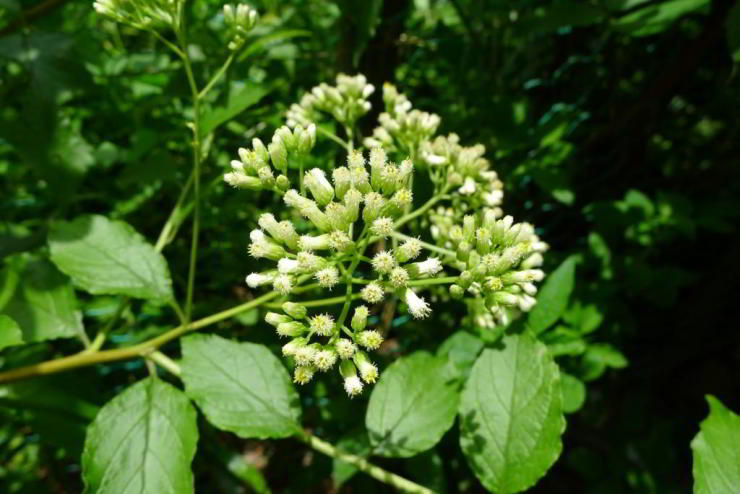A versatile plant renowned for its medicinal properties has been traditionally utilized across Africa for centuries.
Microglossa pyrifolia, commonly known as the shrubby and climbing plant, exhibits distinctive characteristics. Its stem is adorned with a delicate covering of fine glandular pubescence, adding to its aesthetic allure and tactile appeal. The leaves, alternately arranged along the stem, are notable for their simplicity, their short petiolate nature, and oval-shaped morphology.
A striking feature of this plant is its inflorescence, which takes the form of a branched panicle composed of yellowish-white capitulums clustered densely in corymb-shaped groups. These capitulums, arranged in such a manner, contribute to the plant’s overall visual impact and attract pollinators with their vibrant hues.
Moreover, the basal bracts of the involucre persist, providing structural support and protection to the developing reproductive organs. Microglossa pyrifolia thrives in various habitats, including forest edges, open forests, wetlands, and plantations, with a particular affinity for agroforestry systems.
Microglossa pyrifolia, a versatile plant renowned for its medicinal properties, has been traditionally utilized across Africa for centuries. This erect or scandent shrub, reaching heights of up to 5 meters, thrives in diverse habitats, including forest edges, river forests, grasslands, bushlands, and wastelands.
Local communities have long relied on Microglossa pyrifolia for treating a myriad of ailments, showcasing its remarkable therapeutic versatility. Notably, it was historically employed for the treatment of snakebites, with efficacy noted against various venomous species, except for the puff adder bites. The plant’s efficacy in this regard highlights its significance in traditional medicine practices, offering potential relief and protection against life-threatening situations.
Indigenous peoples have ingeniously harnessed the healing potential of Microglossa pyrifolia across diverse cultures and regions. In some communities, the above-ground parts and roots of the plant Indigofera spicata are combined for the treatment of meningitis, showcasing synergistic medicinal applications within local herbal traditions. Additionally, the leaves of Microglossa pyrifolia have been employed for addressing hard swellings on the skin and for managing jaundice and herpes outbreaks.
Moreover, Microglossa pyrifolia features prominently in the treatment of malaria-related symptoms, reflecting its integral role in combating one of the most prevalent and debilitating tropical diseases. The decoction of its roots serves as a remedy for stomach aches, offering relief from gastrointestinal discomfort through traditional herbal preparations.
In some communities, the plant is utilized for enemas to alleviate fever in infants, showcasing its application in pediatric care within indigenous healthcare systems. Similarly, in Liberia, the plant is esteemed as a remedy for coughs, demonstrating its efficacy in managing respiratory ailments.
In Tanzania, the plant is revered for its efficacy in treating headaches and colds, offering symptomatic relief to individuals suffering from common afflictions. Moreover, in West Africa, the powdered root of Microglossa pyrifolia is utilized as snuff to alleviate cold symptoms, highlighting its diverse modalities of administration and cultural significance.
The therapeutic potential of Microglossa pyrifolia extends beyond internal ailments to encompass external afflictions as well. In West Tropical Africa, the juice extracted from its roots is applied as eye drops, suggesting its efficacy in addressing ocular conditions such as cataracts. Additionally, the warmed leaves of the plant are applied topically to treat ringworm of the scalp, showcasing its dermatological applications.
Furthermore, Microglossa pyrifolia is valued for its ability to induce sweating, aiding in the management of fevers and associated symptoms. Its tea-like infusion serves as a remedy for fever accompanied by headaches, offering a natural approach to fever management within traditional healing paradigms.
In childbirth, the decoction of Microglossa pyrifolia is administered to women in labour, potentially facilitating childbirth and easing labour pains through its medicinal properties. Moreover, in Tanzania, the decoction of its roots and root bark is utilised for managing epilepsy, highlighting its application in neurological disorders within indigenous healthcare systems.
In Rwanda, Microglossa pyrifolia finds utility in addressing conditions such as coughs, elephantiasis, and wounds, reflecting its widespread acceptance and efficacy across diverse health concerns. Additionally, in Ethiopia, the plant is utilized for treating mastitis, showcasing its relevance in addressing lactational issues among livestock. The Bench people, in particular, combine the leaves and roots of Microglossa pyrifolia with Indigofera spicata for the treatment of meningitis, further emphasizing its collaborative therapeutic potential within indigenous healing practices.
In Kenya, pounded roots of Microglossa pyrifolia are employed for alleviating colds and headaches, while infusions of its leaves are utilized for malaria management. Moreover, pounded leaves are utilized for treating limb fractures, underscoring the plant’s orthopaedic applications within traditional medicine.
Across Cameroon, the softened leaves of Microglossa pyrifolia are consumed as a vermifuge, offering a natural approach to parasitic infections. Similarly, in Ghana, the plant is esteemed for its efficacy in treating dermal infections and wounds, providing relief and promoting healing in cases of cutaneous ailments.
From snakebite remedies to treatments for malaria, coughs, and wounds, its multifaceted therapeutic utility underscores its significance in indigenous healthcare systems. As communities continue to cherish and harness its healing potential, Microglossa pyrifolia remains a testament to the rich tradition of herbal medicine and the enduring wisdom of nature. (Richard Komakech) – (CC BY-SA 4.0/Hsiengan Huang)







